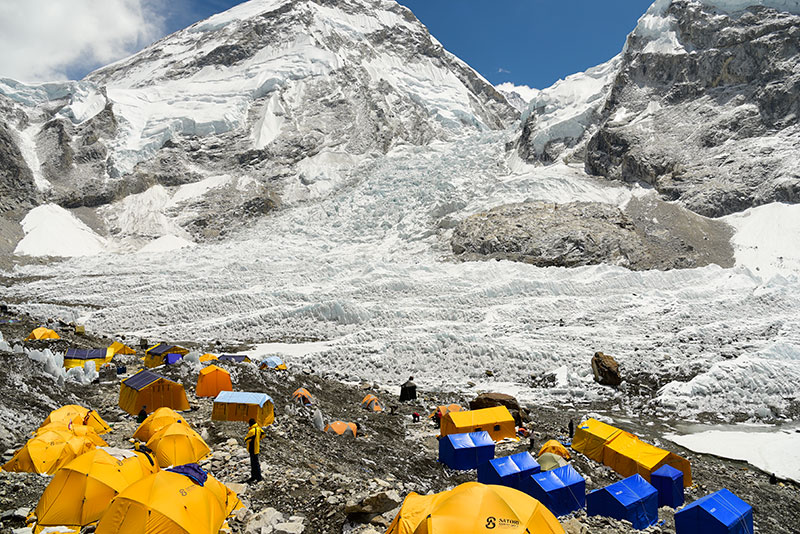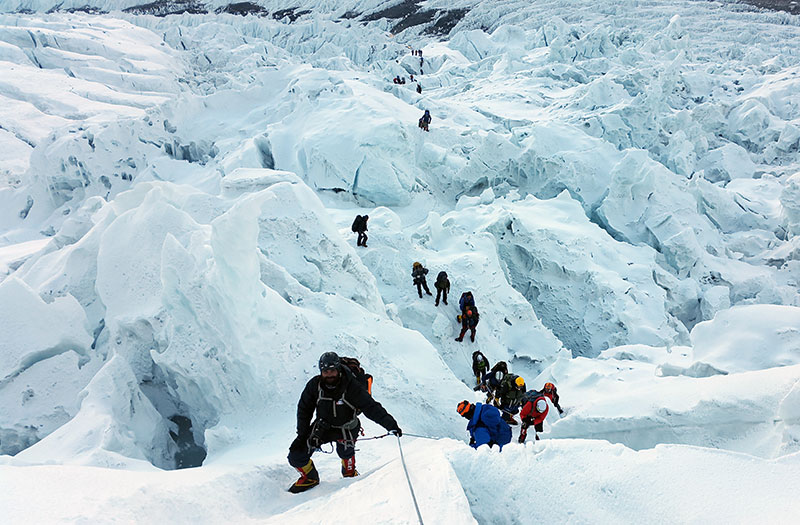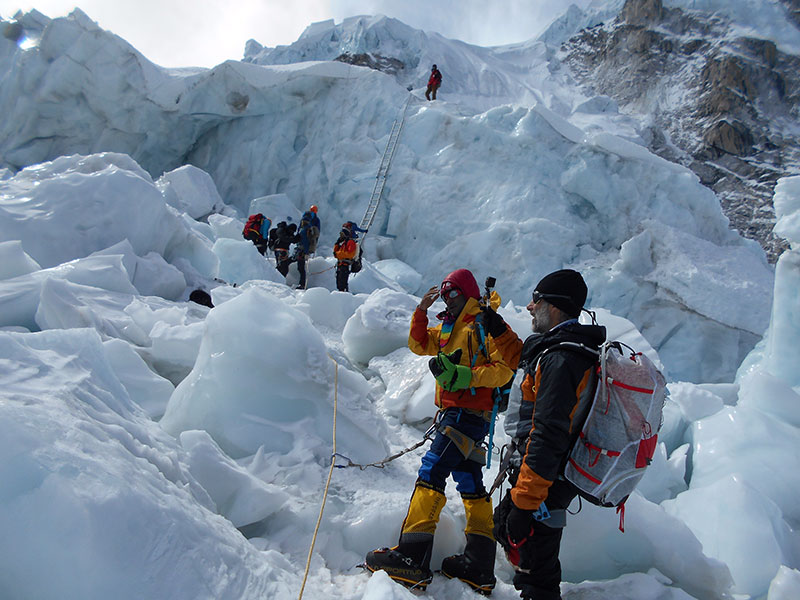The Khumbu Icefall, which lies a short distance from Everest Base Camp and ranges from 5200 meters (17,060ft) to 5800 meters (29029ft), is an ever-changing and fast-moving river of ice that continues to challenge and inspire mountaineers from all over the world. The icefall is situated at the lower end of the Western Cwm, the start of the Khumbu Glacier, one of the highest and largest glaciers in Nepal running approximately 15 km and beginning high on the Lhotse Face at around 7500 meters (24606ft). This glacier moves with such speed that large crevasses open with little warning and large ice towers (called seracs) have been known to collapse suddenly causing blocks of ice the size of cars to houses to tumble down the glacier.
George Mallory, while seeking a route to climb to the summit of Everest is said to have sighted the Icefall in the early 1920s, describing it as “terribly steep and broken …” and concluding “all in all the approach to the mountain from Tibet is easier.“ Mallory thus shifted his efforts to Tibet as a better bet to reach the summit of the world’s tallest mountain.
It wasn’t until 1950 when Charlie Houston and Bill Tilman led a British reconnaissance team to scout a possible route from Nepal that the Khumbu Icefall was considered feasible. In 1951, another British team lead by Eric Shipton climbed through the Icefall but was stopped just short of the top due to a wide crevasse. Early expeditions used ladders and, when they ran out, long tree trunks brought a long way from the tree line to cross crevasses. A Swiss team in 1952 overcame that obstacle by climbing into the crevasse and crossing a dangerous snow bridge to reach 8500 meters, but failed to summit. John Hunt’s 1953 British expedition used that same route to successfully make the first summit Everest.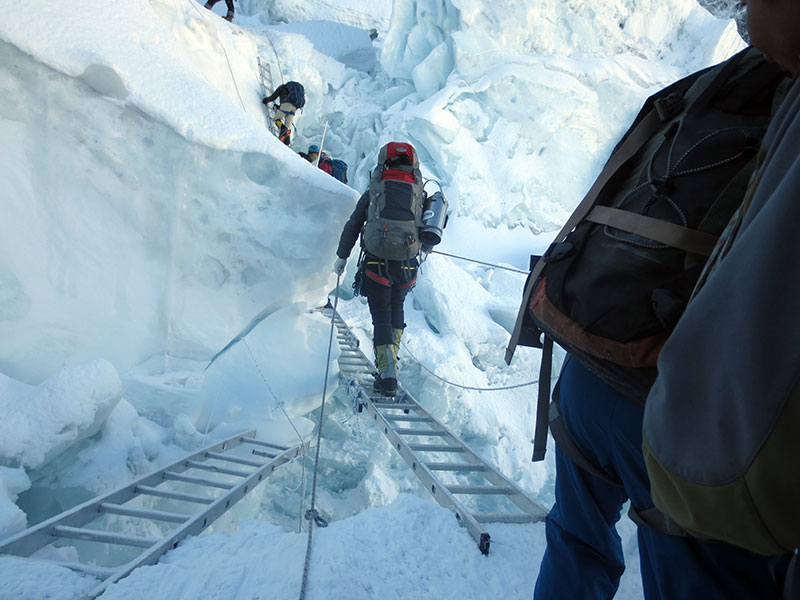
According to the mountain research institute in the world, the combination of the effects of global warming and greater human activities due to continuing popularity of Everest, the Khumbu Glacier is melting and becoming more challenging for fixed line climbing. Estimations are that the glacier has thinned by 40-50’/12-15m over most of the length. The area of Everest Base Camp is down and down each day due to the ice melting. In 1953 when Tenzing Sherpa and Edmund Hillary attempted to summit Everest, Everest Base Camp’s height was estimated at 5320 meters. Today it measures at around 5200 meters. The Kathmandu Research Center has estimated that the glacier advances 1.2 meters down the mountain every year.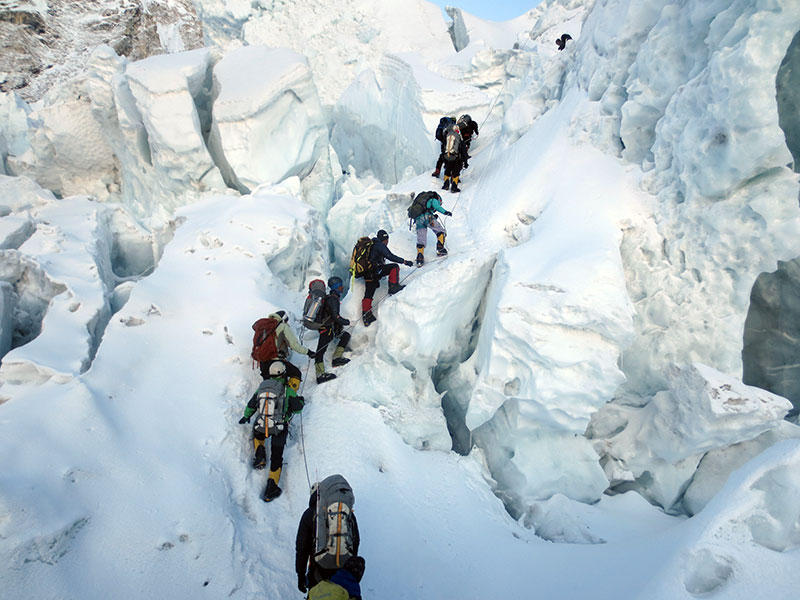
For trekkers who plan to reach Everest Base Camp, the sequence and condition of the Khumbu Icefall is largely irrelevant; EBC trekkers will not trek any portion of the Icefall (though it can be observed). On the other hand, the Khumbu Icefall poses significant danger for Everest, Lhotse and Nuptse climbers. Most of the climbers try to cross the Khumbu icefall during the very early morning before sunrise when it is less susceptible to movement. As the oft-intense sunlight warms the area the chances of crevasses opening or blocks falling becomes much greater. Generally speaking, the most unsafe and challenging time to cross the Khumbu Icefall is generally mid- to late-afternoon. Strong, acclimatized climbers can ascend the Icefall in a few hours but for first time or less experienced climbers, the time may increase significantly.
To assist climbers, the “Sagarmath Pollution Control Committee” (SPCC) is authorized by the Government of Nepal and Department of Tourism to open routes by using ladders to cross crevasses in the Icefall and fix rope up to Camp II. Crevasses may generally range from 1 to 10 meters in width. But even extensive rope and ladder crossings cannot prevent loss of life and of course many climbers have lost their lives in this area. Exposed crevasses may be easy to avoid but others may be hidden under dangerous snow bridges through which unwary climbers can fall.
Given the continuing popularity of Everest, traffic on the mountain is thick and climbers may wait 30 minutes to an hour to cross fixed ladders. While waiting, climbers may hear or see large blocks of ice crashing down in their vicinity, creating additional risks for climbers. The resulting blast of displaced air and snow can result in a “dusting,” a very unnerving experience. If a climber is caught in an avalanche or other “movement” event in the Icefall, there is very little they can do except prepare for potential entrapment. It is virtually impossible to run away or even to know which way to run. There are more than 800 persons, including climbers, climbing Sherpa guides and Camp II staff ascending and descending between Advance Base Camp and Camp via the Khumbu Ice fall. This is a lot of people above the ice! It’s also what is thought to add to the effect of melting ice increasing the challenge in an area challenging and dangerous enough.
The months of April and May are the best months for mountaineering adventures in the Himalayas. Kalapather (5554 meters) provides a beautiful observation point of the Khumbu Icefall and a panoramic view of the Everest region at a height of 5,554.


